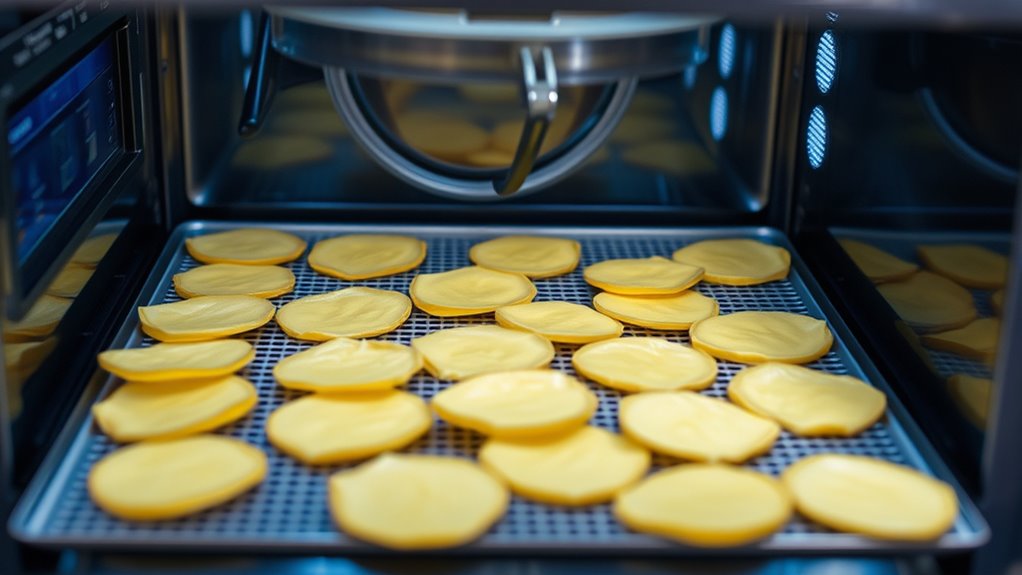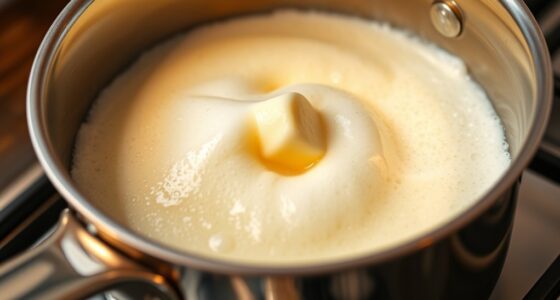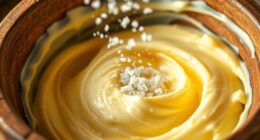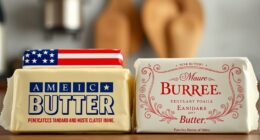Microwave vacuum dehydration quickly turns butter into crispy, flavorful crisps by removing moisture under low pressure and gentle microwave energy. You start by selecting high-quality butter, spreading it thinly, and placing it in a vacuum chamber. Adjust the microwave power and vacuum levels for even dehydration, ensuring you monitor moisture to prevent over-drying. If you want tips on perfecting the process, exploring troubleshooting, and storage ideas, keep exploring this innovative technique.
Key Takeaways
- Microwave vacuum dehydration quickly removes moisture while preserving butter’s natural flavor and crisp texture.
- Proper equipment setup and preparation ensure even dehydration and high-quality butter crisps.
- Monitoring microwave power and vacuum levels prevents over-drying or uneven results.
- Regular equipment maintenance and safe operation practices extend equipment lifespan and ensure safety.
- Store butter crisps in airtight, moisture-proof containers to maintain freshness and prolong shelf life.
Understanding Microwave Vacuum Dehydration Technology

Have you ever wondered how microwave vacuum dehydration efficiently removes moisture from food while preserving its quality? This innovative process combines microwave energy with a vacuum environment to accelerate dehydration. By reducing the boiling point of water, it allows moisture to escape quickly without damaging delicate flavors like butter flavor. The dehydration speed is markedly faster compared to traditional methods, minimizing heat exposure and preserving the food’s natural qualities. The vacuum lowers pressure, enabling moisture to evaporate at lower temperatures, which helps maintain texture and flavor integrity. This synergy of microwave power and vacuum conditions ensures rapid, gentle drying, making it ideal for creating high-quality butter crisps. Additionally, understanding the role of contrast ratio in image quality reveals how visual clarity and depth are preserved during dehydration processes. Understanding this technology reveals how it optimizes dehydration while protecting the food’s essential characteristics.
Benefits of Using Microwave Vacuum Dehydration for Butter Crisps

Using microwave vacuum dehydration for butter crisps offers significant advantages. It helps maintain the original flavor while speeding up the drying process. Plus, it ensures that each piece dries evenly for consistent quality. Additionally, this method aligns with ethical hacking principles by minimizing damage to the product and ensuring safety during processing.
Preserves Flavor Integrity
Because microwave vacuum dehydration operates at lower temperatures, it effectively preserves the delicate flavors of butter crisps. This method minimizes heat exposure that can cause flavor degradation, guaranteeing the natural, rich taste remains intact. As a result, you’ll notice excellent flavor retention, capturing the butter’s authentic aroma and subtle nuances. Additionally, the gentle dehydration process helps maintain the crisp texture that makes butter crisps so appealing. The preservation of both flavor and texture means you get a product that’s fresh-tasting and satisfying with each bite. This approach prevents the common loss of delicate flavors associated with traditional drying methods, allowing you to enjoy butter crisps that are true to their original quality. Ultimately, microwave vacuum dehydration ensures your butter crisps stay flavorful and crisp longer. AI safety measures and continuous monitoring can further enhance the process by minimizing potential quality issues.
Accelerates Drying Process
Microwave vacuum dehydration not only preserves flavor but also considerably speeds up the drying process. This method reduces dehydration time markedly compared to traditional techniques, allowing you to achieve crispy butter crisps faster. Because the process occurs under vacuum, moisture is removed quickly without exposing the product to high heat, which helps maintain flavor retention. Faster drying also means less risk of texture degradation, resulting in a crisp, satisfying bite. The rapid process minimizes the chance of over-drying or developing off-flavors, ensuring your butter crisps stay fresh and flavorful. Additionally, integrating natural materials like wood and linen in the process can enhance the overall quality and authenticity of your finished product. Overall, microwave vacuum dehydration streamlines production, saving you time while enhancing the texture and taste of your final product. This efficiency makes it an ideal choice for high-quality, crispy butter snacks.
Ensures Uniform Dehydration
Since microwave vacuum dehydration applies evenly distributed microwave energy under controlled pressure, it promotes uniform moisture removal throughout the butter crisps. This consistent evaporation prevents over-drying or uneven spots, ensuring each piece maintains excellent quality. As a result, you’ll notice better flavor retention and a more consistent texture. Uniform dehydration also helps preserve delicate structure, enhancing crispness without becoming brittle. This even process minimizes defects and guarantees a high-quality product.
| Aspect | Benefit | Outcome |
|---|---|---|
| Flavor retention | Preserves natural flavors | Tastes fresh and authentic |
| Texture enhancement | Ensures crisp, consistent crunch | Improves product uniformity |
| Dehydration uniformity | Prevents uneven dryness | Guarantees quality control |
Essential Equipment and Materials Needed

To effectively carry out microwave vacuum dehydration, you’ll need specific equipment and materials designed for precision and efficiency. Proper tools guarantee you achieve the ideal butter texture and maximize flavor enhancement. Essential items include a microwave vacuum dryer for controlled dehydration, a quality vacuum pump to remove moisture, a digital thermometer to monitor temperature, and silicone mats to prevent sticking. These tools help maintain consistent results, preserving butter’s quality and flavor. The right equipment also minimizes dehydration time and reduces the risk of overprocessing, ensuring your crisps develop the perfect crunch. Investing in reliable, specialized devices is key to creating high-quality butter crisps, elevating your culinary process and final product. Focusing on precise dehydration techniques can significantly improve the texture and flavor of your crisps.
Preparing Butter for Dehydration

Before dehydrating butter, you need to prepare it properly to guarantee ideal results. Start by selecting high-quality butter with a strong butter flavor, as this will enhance the taste of your crisps. To ensure even dehydration, melt the butter slightly or spread it thinly on a parchment-lined tray. This helps maintain consistent dehydration and prevents uneven texture. Use simple dehydration techniques—such as spreading the butter evenly—to promote uniform moisture removal. Avoid overcrowding or stacking pieces, which can hinder airflow and prolong dehydration time. Once prepared, allow the butter to cool slightly if melted, then cut it into thin, uniform layers or pieces. Proper preparation ensures the dehydration process runs smoothly, resulting in crispy, flavorful butter crisps. Incorporating proper preparation techniques can further improve your dehydration results and overall snack quality.
Setting Up Your Microwave Vacuum Dehydrator

To get started, you need the right equipment that fits your dehydration needs. Next, prepare a clean, well-ventilated space to set up your microwave vacuum dehydrator safely. Finally, adjust your microwave settings for maximum dehydration without overcooking your items. Be sure to consider privacy policies to understand how your data and preferences will be managed during your setup process.
Choose Suitable Equipment
Have you selected the right equipment for your microwave vacuum dehydration process? Choosing suitable equipment guarantees efficient dehydration and safe operation. Look for a microwave with adjustable power levels and a reliable vacuum system. Confirm the equipment allows easy access for cleaning and maintenance, which helps prolong its lifespan. Remember, regular equipment maintenance is essential to prevent malfunctions. Pay close attention to safety precautions, such as properly sealing the chamber and avoiding overheating. Incorporating biodiversity-friendly practices in your setup can also enhance sustainability and reduce environmental impact.
Prepare Dehydration Space
Setting up your microwave vacuum dehydrator in a dedicated, clutter-free space guarantees safe and efficient operation. Clear your area of unnecessary items to prevent accidents and ensure proper airflow. A well-organized space improves dehydration efficiency and makes equipment maintenance easier. Use the following table to optimize your setup:
| Location | Surface | Additional Items |
|---|---|---|
| Stable | Heat-resistant | Storage containers |
| Ventilated | Non-slip | Cleaning supplies |
| Accessible | Clean | Power source |
Position your dehydrator on a stable, heat-resistant surface with easy access to power outlets. Keep the area well-ventilated to prevent heat buildup. Proper setup minimizes risks and maximizes dehydration efficiency. Maintaining a clutter-free environment supports safe operation and prolongs the lifespan of your equipment.
Optimize Microwave Settings
Adjusting your microwave vacuum dehydrator’s settings properly guarantees efficient dehydration without damaging your items. To ensure microwave safety and flavor preservation, start with low power and short intervals, gradually increasing as needed. Pay attention to the dehydration progress, preventing overheating that can ruin texture or taste. Use the following tips for optimal results:
- Set the power level to avoid rapid heating that can compromise flavor
- Monitor moisture levels frequently to prevent over-drying
- Use a timer to prevent prolonged exposure, maintaining microwave safety
- Adjust microwave settings based on the thickness and moisture content of your butter crisps
- Keep in mind that automation technologies are increasingly used in food processing, highlighting the importance of precise control over microwave settings for consistent results.
Step-by-Step Process for Making Butter Crisps

To make butter crisps using microwave vacuum dehydration, start by selecting high-quality, unsalted butter and slicing it into thin, even pieces. This guarantees consistent dehydration and preserves the rich butter flavor. Place the slices in a single layer on a microwave-safe tray designed for vacuum dehydration. Use appropriate dehydration techniques by setting your microwave to the recommended low power level, which helps gently remove moisture without burning the butter. Dehydrate until the slices turn crisp and dry, usually taking several minutes. Avoid over-dehydrating, as it can cause unnecessary browning or flavor loss. Once done, let the crisps cool completely before storing. This process creates a crispy texture while maintaining the butter’s natural flavors, perfect for making butter crisps.
Monitoring and Adjusting Dehydration Parameters

Monitoring dehydration parameters is essential to guarantee your butter crisps turn out perfectly. By keeping an eye on factors like temperature, vacuum level, and dehydration time, you can control dehydration speed and prevent over-drying. Adjusting these parameters helps preserve flavor retention, ensuring your crisps maintain their rich butter flavor. Regularly check the moisture content during dehydration to avoid under- or over-processing. Fine-tuning the microwave power and vacuum settings allows you to optimize dehydration, balancing speed with quality. Remember, slow dehydration might improve flavor, but too slow can lead to uneven results. Conversely, too rapid dehydration risks flavor loss and texture issues. Staying attentive and flexible with your parameters ensures you achieve the ideal crispiness and flavor retention you desire.
Tips for Achieving Optimal Crispiness and Flavor

Achieving the perfect balance between crispiness and rich flavor in microwave vacuum dehydration requires careful attention to technique. To enhance the butter flavor, start with high-quality butter and avoid overcooking, which can diminish taste. Maintain consistent dehydration times and power levels to develop a crisp texture without burning the butter. Using thin, even layers ensures uniform dehydration and prevents sogginess. Keep a close eye on the process; slight adjustments can make a big difference in flavor and crispiness. Incorporating a brief rest period after dehydration allows moisture redistribution, boosting crunch. Remember, patience is key—rushing can compromise the butter flavor and crisp texture. With precise control and attention to detail, you’ll create butter crisps that deliver excellent flavor and satisfying crunch.
Troubleshooting Common Challenges

Even with careful technique, you might encounter common challenges during microwave vacuum dehydration, such as uneven drying, sogginess, or burnt spots. These issues can hinder flavor retention and prevent the desired texture enhancement. To troubleshoot effectively:
- Adjust microwave power settings to prevent scorching and ensure even heat distribution.
- Monitor dehydration time closely to avoid sogginess or over-drying.
- Use proper vacuum levels to promote uniform moisture removal.
- Rotate or rearrange butter slices during dehydration for consistent crispness.
Addressing these challenges helps preserve the delicate flavors and improves texture. Consistent attention to process details minimizes common pitfalls, leading to high-quality butter crisps with ideal flavor retention and a satisfying crunch.
Creative Uses and Storage of Homemade Butter Crisps

Once you’ve made your butter crisps, it’s important to store them properly to keep them fresh and flavorful. You can get creative by using them as toppings or mix-ins in various dishes. Plus, learning some long-term preservation tips guarantees your butter crisps stay tasty for months to come.
Storing Butter Crisps Safely
Are you wondering how to keep your homemade butter crisps fresh and crunchy? Proper storage is key to preserving their butter flavor and crisp texture. To avoid staleness, store them in an airtight container away from humidity and heat. Consider using silicone or glass jars for better sealing. Keep them in a cool, dark place to prevent butter from melting or losing its flavor. If you want to extend their shelf life, freeze the crisps and let them thaw at room temperature before serving. Remember, moisture is the enemy of crispness, so avoid stacking them with other items. Proper storage guarantees your butter crisps stay flavorful and maintain their satisfying crunch.
- Use airtight containers for maximum freshness
- Keep in a cool, dark environment
- Avoid stacking to prevent moisture transfer
- Freeze for longer storage
Creative Culinary Applications
Homemade butter crisps aren’t just a tasty snack; they also serve as versatile ingredients for creative culinary uses. Their rich butter flavor enhances both sweet and savory dishes, while their crispy texture adds a satisfying crunch. You can crumble them over salads for extra flavor or sprinkle them onto baked potatoes for added richness. Incorporate them into crusts for tarts or use them as a topping for desserts like ice cream or yogurt. Butter crisps also work well as a garnish for soups or stews, providing a delightful contrast. Their portability makes them perfect for snacks on the go or as a unique addition to charcuterie boards. With a little creativity, these crisps can elevate many recipes, adding depth of flavor and appealing texture.
Long-Term Preservation Tips
To preserve the crispness and flavor of your butter crisps for the long term, proper storage is essential. Keep them in airtight containers to prevent moisture from compromising their texture and flavor enhancement. Store in a cool, dark place to maintain their crunch and prevent stale taste. Consider adding a desiccant packet to absorb excess humidity, ensuring texture preservation. For extended storage, vacuum-sealing can lock in freshness and flavor, preventing oxidation. Regularly check your crisps for any signs of moisture or spoilage. Proper storage not only prolongs shelf life but also keeps your butter crisps delicious and crunchy for months.
- Use airtight containers to lock in flavor and prevent moisture
- Store in a cool, dark environment for freshness
- Add desiccants to absorb humidity
- Vacuum-seal for maximum preservation
Frequently Asked Questions
Can I Dehydrate Flavored or Seasoned Butter?
You can dehydrate flavored or seasoned butter, but flavor preservation is key. Using microwave vacuum dehydration helps retain more of the butter’s original taste while removing moisture efficiently. For seasoning techniques, add herbs, spices, or other seasonings after dehydration to keep their flavors vibrant. Be sure to test small batches first, as some seasonings may lose potency during dehydration. This way, you maintain the butter’s flavor and achieve crispy, delicious butter crisps.
How Long Does the Dehydration Process Typically Take?
Imagine waiting for your butter to turn into crispy gold—sounds like a patience test, right? Well, dehydration timing depends on your method’s efficiency, but with microwave vacuum dehydration, it usually takes about 15-30 minutes. You get quick, even results without the popcorn-style chaos. So, if you’re enthusiastic to snack, just keep an eye on your butter, and your crispy treats will be ready faster than you think!
Is Microwave Vacuum Dehydration Safe for All Butter Types?
You might wonder if microwave vacuum dehydration is safe for all butter types. Generally, it’s safe, but the butter’s texture and moisture content can influence dehydration safety. Some butters with high moisture or added ingredients might not dehydrate evenly, affecting texture and safety. Always check the butter’s composition and follow proper procedures to guarantee safety and achieve the desired crispy texture, regardless of butter type.
How Do I Prevent Butter From Melting During Dehydration?
Imagine a delicate snowflake resisting the sun—your butter needs similar gentle care. To prevent melting during dehydration, you should focus on precise temperature control and choose appropriate dehydration techniques. Keep the temperature low and steady, avoiding sudden spikes. Using gentle heat and consistent conditions allows the butter to dry without melting, ensuring crisp, perfect results. Proper temperature regulation is your best tool for successful dehydration without compromising butter integrity.
Can I Use This Method for Other Dairy Products?
Yes, you can use dehydration techniques for other dairy products, but you need to contemplate their unique properties. Dairy preservation varies, so some items like cheese or yogurt might not dehydrate well without changes. Microwave vacuum dehydration is gentle, helping retain flavor and texture. Always test small batches first, adjusting time and temperature to prevent melting or spoilage, ensuring effective dairy preservation through these dehydration methods.
Conclusion
With microwave vacuum dehydration, you hold the key to transforming butter into irresistible crisps. Think of it as shaping a delicate sculpture from a block of ice—you control the process, revealing a new layer of flavor and crunch. Embrace the technique, and you’ll open endless culinary possibilities. Your homemade butter crisps aren’t just snacks; they’re a proof to your creativity—delicate, bold, and uniquely yours. Now, go craft your crispy masterpiece and savor the magic you create.









